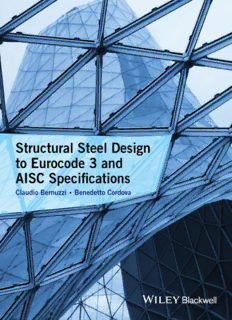Table Of ContentStructural Steel Design to Eurocode 3
and AISC Specifications
Structural Steel Design to Eurocode 3
and AISC Specifications
By
Claudio Bernuzzi
and
Benedetto Cordova
Thiseditionfirstpublished2016
©2016byJohnWiley&Sons,Ltd
RegisteredOffice
JohnWiley&Sons,Ltd,TheAtrium,SouthernGate,Chichester,WestSussex,PO198SQ,UnitedKingdom
EditorialOffices
9600GarsingtonRoad,Oxford,OX42DQ,UnitedKingdom
TheAtrium,SouthernGate,Chichester,WestSussex,PO198SQ,UnitedKingdom
Fordetailsofourglobaleditorialoffices,forcustomerservicesandforinformationabouthowtoapplyfor
permissiontoreusethecopyrightmaterialinthisbookpleaseseeourwebsiteatwww.wiley.com/wiley-blackwell.
TherightoftheauthortobeidentifiedastheauthorofthisworkhasbeenassertedinaccordancewiththeUK
Copyright,DesignsandPatentsAct1988.
Allrightsreserved.Nopartofthispublicationmaybereproduced,storedinaretrievalsystem,ortransmitted,
inanyformorbyanymeans,electronic,mechanical,photocopying,recordingorotherwise,exceptas
permittedbytheUKCopyright,DesignsandPatentsAct1988,withoutthepriorpermissionofthepublisher.
Designationsusedbycompaniestodistinguishtheirproductsareoftenclaimedastrademarks.Allbrand
namesandproductnamesusedinthisbookaretradenames,servicemarks,trademarksorregistered
trademarksoftheirrespectiveowners.Thepublisherisnotassociatedwithanyproductorvendormentioned
inthisbook.
LimitofLiability/DisclaimerofWarranty:Whilethepublisherandauthor(s)haveusedtheirbesteffortsin
preparingthisbook,theymakenorepresentationsorwarrantieswithrespecttotheaccuracyorcompleteness
ofthecontentsofthisbookandspecificallydisclaimanyimpliedwarrantiesofmerchantabilityorfitnessfora
particularpurpose.Itissoldontheunderstandingthatthepublisherisnotengagedinrenderingprofessional
servicesandneitherthepublishernortheauthorshallbeliablefordamagesarisingherefrom.Ifprofessional
adviceorotherexpertassistanceisrequired,theservicesofacompetentprofessionalshouldbesought.
BasedonProgettoeverificadellestruttureinacciaiobyClaudioBernuzzi.
©UlricoHoepliEditoreS.p.A.,Milano,2011.PublishedintheItalianlanguage.
LibraryofCongressCataloging-in-Publicationdataappliedfor.
ISBN:9781118631287
AcataloguerecordforthisbookisavailablefromtheBritishLibrary.
Wileyalsopublishesitsbooksinavarietyofelectronicformats.Somecontentthatappearsinprintmaynotbe
availableinelectronicbooks.
Coverimage:photovideostock/Getty
Setin10/12ptMinionbySPiGlobal,Pondicherry,India
1 2016
Contents
Preface x
1 TheSteelMaterial 1
1.1 GeneralPoints about theSteel Material 1
1.1.1 Materials in Accordancewith European Provisions 4
1.1.2 Materials in Accordancewith United States Provisions 7
1.2 Production Processes 10
1.3 Thermal Treatments 13
1.4 Brief Historical Note 14
1.5 The Products 15
1.6 Imperfections 18
1.6.1 Mechanical Imperfections 19
1.6.2 GeometricImperfections 22
1.7 Mechanical Tests for the Characterizationof theMaterial 24
1.7.1 Tensile Testing 25
1.7.2 Stub Column Test 27
1.7.3 Toughness Test 29
1.7.4 Bending Test 32
1.7.5 Hardness Test 32
2 References for theDesign of Steel Structures 34
2.1 Introduction 34
2.1.1 European Provisions for Steel Design 35
2.1.2 United States Provisions for Steel Design 37
2.2 Brief Introduction toRandom Variables 37
2.3 Measure of the Structural Reliability andDesign Approaches 39
2.4 Design Approaches inAccordancewith Current Standard Provisions 44
2.4.1 European Approach for Steel Design 44
2.4.2 United States Approach for Steel Design 47
3 Framed Systems andMethods of Analysis 49
3.1 Introduction 49
3.2 Classification Based onStructural Typology 51
3.3 Classification Based onLateralDeformability 52
3.3.1 European Procedure 53
3.3.2 AISC Procedure 56
vi Contents
3.4 ClassificationBasedon Beam-to-Column Joint Performance 56
3.4.1 Classification According tothe European Approach 57
3.4.2 Classification According tothe United States Approach 60
3.4.3 Joint Modelling 61
3.5 GeometricImperfections 63
3.5.1 The European Approach 63
3.5.2 The United States Approach 67
3.6 The Methods of Analysis 68
3.6.1 Plasticity and Instability 69
3.6.2 Elastic Analysis withBending Moment Redistribution 76
3.6.3 Methods of Analysis Considering Mechanical Non-Linearity 78
3.6.4 Simplified Analysis Approaches 80
3.7 Simple Frames 84
3.7.1 Bracing System Imperfections in Accordance withEU Provisions 88
3.7.2 System Imperfectionsin Accordancewith AISCProvisions 89
3.7.3 Examples ofBraced Frames 92
3.8 Worked Examples 96
4 Cross-Section Classification 107
4.1 Introduction 107
4.2 Classificationin Accordancewith European Standards 108
4.2.1 Classification for Compression or Bending Moment 110
4.2.2 Classification for Compression and Bending Moment 110
4.2.3 Effective GeometricalPropertiesfor Class4 Sections 115
4.3 Classificationin Accordancewith USStandards 118
4.4 Worked Examples 121
5 TensionMembers 134
5.1 Introduction 134
5.2 Design According tothe European Approach 134
5.3 Design According tothe USApproach 137
5.4 Worked Examples 140
6 Members in Compression 147
6.1 Introduction 147
6.2 Strength Design 147
6.2.1 Design According tothe European Approach 147
6.2.2 Design According tothe USApproach 148
6.3 Stability Design 148
6.3.1 Effect ofShear on theCritical Load 155
6.3.2 Design According tothe European Approach 158
6.3.3 Design According tothe USApproach 162
6.4 Effective Length of Members inFrames 166
6.4.1 Design According tothe EU Approach 166
6.4.2 Design According tothe USApproach 169
6.5 Worked Examples 172
7 Beams 176
7.1 Introduction 176
7.1.1 Beam Deformability 176
Contents vii
7.1.2 Dynamic Effects 178
7.1.3 Resistance 179
7.1.4 Stability 179
7.2 European Design Approach 184
7.2.1 ServiceabilityLimitStates 184
7.2.2 ResistanceVerifications 186
7.2.3 Buckling Resistance ofUniform MembersinBending 190
7.3 Design According tothe USApproach 199
7.3.1 ServiceabilityLimitStates 199
7.3.2 Shear Strength Verification 200
7.3.3 Flexural Strength Verification 204
7.4 Design Rules for Beams 228
7.5 Worked Examples 233
8 Torsion 243
8.1 Introduction 243
8.2 Basic Concepts of Torsion 245
8.2.1 I-and H-Shaped Profiles with Two Axes of Symmetry 250
8.2.2 Mono-symmetrical Channel Cross-Sections 252
8.2.3 Warping Constant for Most Common Cross-Sections 255
8.3 Member Response toMixed Torsion 258
8.4 Design in Accordance withthe European Procedure 263
8.5 Design in Accordance withthe AISC Procedure 265
8.5.1 Round and Rectangular HSS 266
8.5.2 Non-HSS Members (Open Sections Such as W,T, Channels,etc.) 267
9 MembersSubjected toFlexure andAxial Force 268
9.1 Introduction 268
9.2 Design According tothe European Approach 271
9.2.1 The Resistance Checks 271
9.2.2 The Stability Checks 274
9.2.3 The General Method 280
9.3 Design According tothe USApproach 281
9.4 Worked Examples 284
10 Design for Combination of Compression, Flexure,Shear and Torsion 303
10.1 Introduction 303
10.2 Design in Accordance withthe European Approach 308
10.3 Design in Accordance withthe USApproach 309
10.3.1 Round and Rectangular HSS 310
10.3.2 Non-HSS Members (Open Sections Such as W,T, Channels,etc.) 310
11 Web Resistance toTransverseForces 311
11.1 Introduction 311
11.2 Design Procedure inAccordance with European Standards 312
11.3 Design Procedure inAccordance with USStandards 316
12 Design Approachesfor Frame Analysis 319
12.1 Introduction 319
12.2 The European Approach 319
viii Contents
12.2.1 The EC3-1Approach 320
12.2.2 The EC3-2a Approach 321
12.2.3 The EC3-2b Approach 321
12.2.4 The EC3-3Approach 322
12.3 AISC Approach 323
12.3.1 The Direct Analysis Method (DAM) 323
12.3.2 The Effective Length Method (ELM) 327
12.3.3 The First Order AnalysisMethod(FOM) 329
12.3.4 Method for ApproximateSecond Order Analysis 330
12.4 Comparison between theEC3 and AISCAnalysisApproaches 332
12.5 Worked Example 334
13 The Mechanical Fasteners 345
13.1 Introduction 345
13.2 Resistance of theBolted Connections 345
13.2.1 ConnectionsinShear 347
13.2.2 ConnectionsinTension 354
13.2.3 Connection inShear andTension 358
13.3 Design inAccordance with European Practice 358
13.3.1 European Practice for Fastener Assemblages 358
13.3.2 EU Structural Verifications 363
13.4 Bolted Connection Design inAccordancewith the USApproach 369
13.4.1 USPracticefor Fastener Assemblage 369
13.4.2 USStructuralVerifications 376
13.5 ConnectionswithRivets 382
13.5.1 Design inAccordance withEU Practice 383
13.5.2 Design inAccordance withUSPractice 383
13.6 Worked Examples 384
14 Welded Connections 395
14.1 Generalities onWeldedConnections 395
14.1.1 European Specifications 397
14.1.2 USSpecifications 399
14.1.3 Classification of Welded Joints 400
14.2 Defects and PotentialProblems inWelds 401
14.3 Stresses in Welded Joints 403
14.3.1 Tension 404
14.3.2 Shear and Flexure 406
14.3.3 Shear and Torsion 408
14.4 Design of Welded Joints 411
14.4.1 Design According tothe European Approach 411
14.4.2 Design According tothe USPractice 414
14.5 Joints with Mixed Typologies 420
14.6 Worked Examples 420
15 Connections 424
15.1 Introduction 424
15.2 Articulated Connections 425
15.2.1 Pinned Connections 426
15.2.2 Articulated Bearing Connections 427

